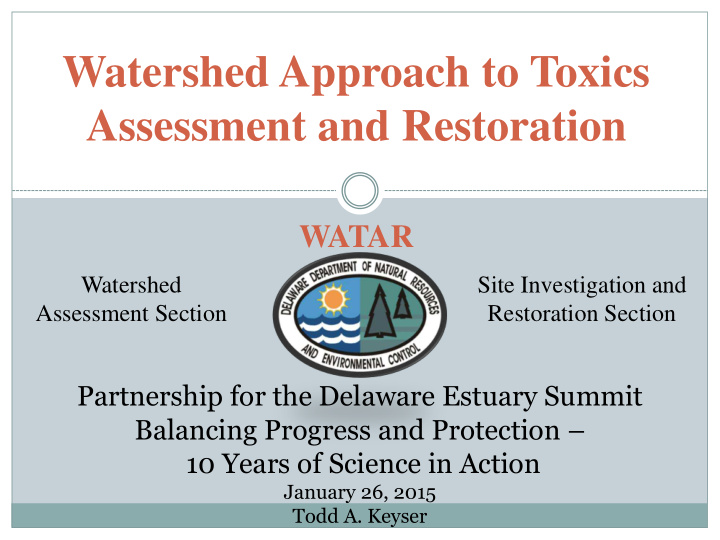



Watershed Approach to Toxics Assessment and Restoration WATAR Watershed Site Investigation and Assessment Section Restoration Section Partnership for the Delaware Estuary Summit Balancing Progress and Protection – 10 Years of Science in Action January 26, 2015 Todd A. Keyser
Background/Context Toxic substances in Delaware surface water are largely a legacy issue. Primary contaminants of concern are P ersistent, B ioaccumulative, and T oxic substances (e.g., PCBs, dioxins & furans, mercury, & organochlorine pesticides). Primary media affected are fish, sediments & soils; heaviest contamination is in areas of greatest industrial/ urban land use. Although situation is improving & programs have been effective overall, problems remain, partly due to a compartmentalized approach.
What is WATAR? A watershed-scale, integrated, and systematic approach to the evaluation of contaminant sources, transport pathways, and receptors. A mechanism to implement and prioritize remediation and/or restoration actions. The primary benefit will be restoration of Delaware watersheds impacted by toxic pollutants to fishable status in the shortest timeframe possible.
Funding & Staffing DNREC is directing ~$1M in existing funding streams over 5 years. Funds being used largely for advanced testing of toxics in surface water, sediments, and biota at known or suspected sources. We will utilize in-house staffing to collect samples; outside labs to analyze the samples; and in-house expertise to manage and interpret the data.
What does this Buy? A “clearing house” of toxics data, accessible first to staff and eventually to the public Detailed assessments of current levels of toxic substances in priority watersheds Linkage between sources and sinks using forensics-grade techniques Toxics TMDLs as needed Sediment guidance under HSCA Identification of high priority remediation projects Partnerships among government and industry Technology transfer
Demonstrated Success of Approach Delaware Estuary PCB TMDL Christina River PBT Assessment NVF Yorklyn/Red Clay Creek Zinc Little Mill Creek/Meco Ditch Delaware River Mercury Methylation Study PCB Trackdown Study Inland Bays Arsenic Assessment Mirror Lake Remediation/Restoration Ft. DuPont permeable reactive barrier Various dredging projects
Little Mill Creek/Meco Ditch Partnership between USACE, NCCD, WAS & SIRS WAS/SIRS sampling determined that Meco Ditch is an ongoing source of PCBs & PAHs to Little Mill Creek & Christina River, including Peterson Marsh Multi-agency effort to address flood risk & environmental impact to receptors concurrently and cooperatively Compelling data and analysis used to approach RP at proximal site to initiate new action
Little Mill Creek/Meco Ditch
PCB Trackback City of Wilmington, NCC, WAS, SIRS, & DRBC effort to determine where PCBs are entering the sewers Loading entering CoW sewage treatment plant not totally removed; residual passes through to Delaware River, exceeding allowable loading “Sewer - shed” approach is effective in determining major sources and sinks of PCBs in the CoW, NCC collection system Known sites, manifests and infrastructure compiled Precise sampling & analysis has quickly determined where major sources are located & provided signatures for other sources Compelling evidence for listing of new sites and prioritization of cleanup at existing sites
PCB Trackback
Mirror Lake, Dover Contaminated sediments in Mirror Lake impeded an ecological restoration project by DNREC Rather than dredge, remedial option used activated carbon (SediMite™) and wetland capping to limit the bioavailability of PCBs, mercury and PAHs Combined remediation and restoration (multi-agency) Final result includes improved habitat and appearance and reduce ecological, wildlife, & human health risks. This is the first State led project of its kind in the U.S., and first full scale application of SediMite™ in the U.S.
Mirror Lake Remediation/Restoration Project compelled Governor Markell to start a “Clean Water for Delaware” initiative
Fort DuPont, Delaware City Former US military landfill washing into Delaware River Exceptionally high lead and other metals in soil and groundwater EPA completed Emergency Removal in November 2014 DNREC supplied EPA with Apatite II ™ , or fish bone, for up-gradient trench backfill to treat shallow groundwater prior to discharge to Delaware River Apatite II ™ used for sequestration of metals Monitoring points sampled in December 2014 to monitor effectiveness
Fort DuPont Photos
Goals for 2015+ Christina River watershed sampling – largest in State Draft of Sediment Guidance Dedicated personnel assigned to database management and data entry of historic data Web-based application for data sharing Identify additional funding sources based upon proven successes Build a self-sustaining WATAR Section within DNREC
WATAR Questions or Comments?
Recommend
More recommend